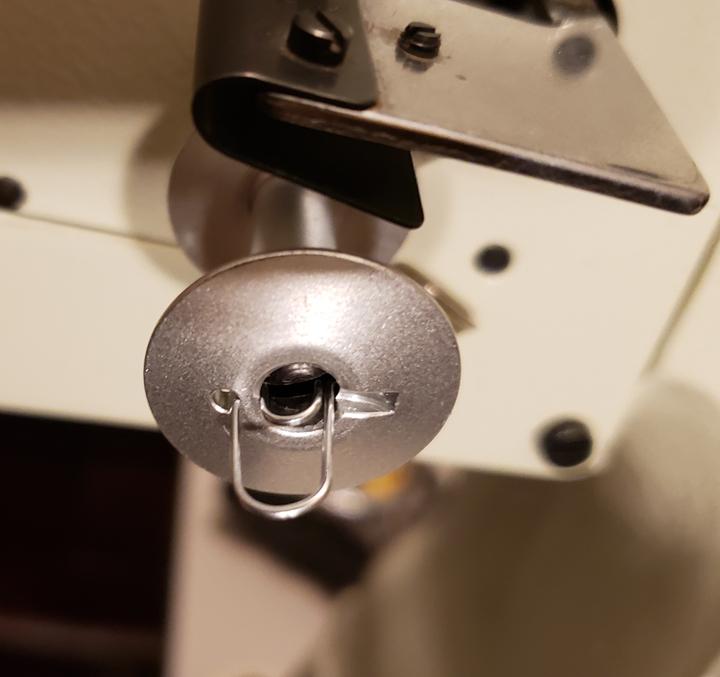-
Posts
7,715 -
Joined
-
Last visited
Content Type
Profiles
Forums
Events
Blogs
Gallery
Posts posted by Wizcrafts
-
-
I'm glad to have helped you make this choice. I love my Singer 168 post machine.
I got a box style reducer for my post machine. The box bolts to the table and the motor bolts to the bottom of the box. this keeps the long belt in about the same position as the original, allowing you to tilt the head back for servicing. Another machine of mine has a 3:1 stand-alone 3 pulley reducer bolted under the table, along side of the belt cutout. The belt from that reducer is more or less directly inline with the head and has to be loosened to tilt the head. It also changes the position of the bobbin winder. Consider the box type reducer. Toledo Industrial Sewing Machines sells them.
-
6 hours ago, Bmwmoa67707 said:
Wiz, thank you for those informative videos. Are there any "land mines" with this machine that one should be aware of? Is 1200 a good price ? I truly do not know..
Thank you,
Steve
Not landmines, but practical limitations. This machine is not meant for heavy thread or thick work. Most people buying this machine are detailing items that are under 1/8 inch thick and soft temper, using bonded thread sizes 33 through 69. It possibly can sew thicker and use #138 thread, but the roller foot only holds down the left side. A #22 needle loaded with #138 thread will probably lift the leather up as it tries to come out with the lockstitch knot. This leads to skipped stitches and ruined projects. Practically, if sewing leather, I wouldn't recommend using thread larger than #92, with a #19 leather point needle, into about 8-9 ounces or so. If sewing cloth or man-made materials, it can handle about 1/4 inch, with #92 thread.
The machine uses G size bobbins and System 134 needles. Here is the Consew product page for the 228R-11-1.
-
Maybe these videos of the Consew 228R-11 in action will help you decide.
-
If rotating the adjuster screw doesn't free the presser bar, open the faceplate cover and observe the bar as you raise and attempt to lower it. You'll probably see where it is hanging up and be able to adjust or oil that part to free it.
-
Here is an operator's manual for the Singer 132k6. Some of the pages were scanned sideways, so print it out to view it.
-
You can replace the knee lever with a foot pedal that bolts onto the pedal bar and uses a chain to connect to a clip on the end of the black lifting bar.
-
An out of round hole in the pressure adjuster screw will cause the foot bar to hang until you rotate it to the right position. Also, add more pressure to overcome the out of round condition.
-
While the Juki LU-1508 series are top of the line machines, they are overkill for wallets and similar thickness projects. You would get just as good a result with a Juki DNU-1541, or even the new Cowboy CB-1541 clone. These machines are medium duty, compound feed, walking foot machines that sew from a couple ounces up to about 20 - 24 ounces (depending on the density of the material. They use smaller thread sizes from 46 through 138, leaving off where your Cobra begins.
-
3 hours ago, RemingtonSteel said:
My Ferdco 2000 Pro came with two bobbins, so I purchased an extra one to try out, before buying several, and encountered this same problem. The replacement bobbin purchased was too large for a friction fit on the Bobbin Winder Spindle. The solution, at least for me was a simple fix, and cost no more than a No. 1 paper clip.
I cut the end of the paper clip that goes through the small hole flush with the inside surface of the bobbin side wall, so that it would not interfere with, or damage the thread. This solution did not involve any modification to the Bobbin Winder Spindle , and actually works well, at least for me anyway.

That is friggin brilliant!
-
3 hours ago, Teslabolt said:
I hear ya - but the fact remains that the tension on the discs never releases or has released since I have received the machine.
Have you verified that your machine actually has push to release pin number 11 inside its channel in the head? You can remove the entire tension assembly and see the end of that pin protruding from the body. Lifting the hand or knee lifter will push it out a bit, which is how the disks get separated. If the pin is missing, order or make a replacement pin. If it is in there and moving with the lifter, but not separating the disks, bend the metal tab on the back of the tension assembly to move the side closest to the pin so it is almost in contact with the pin when the feet are lowered. This will give it the maximum travel when you lift the feet manually.
If the pin is there, but does not protrude out of the channel in the head, it is too short and may need replacing. But, there is an activator on the back side of the head that pushes the pin from the back when the lifter is lifted. If that block is misaligned there won't be enough push on the pin to separate the tension disks.
-
45 minutes ago, RemingtonSteel said:
43+ degrees celsius
That's 109.4 degrees Fahrenheit, for those of us not familiar with non-US measurements.
-
I think you misunderstood what I meant by reversing the handwheel. I meant literally rotating the wheel backwards to reposition the needle to make a turn after it raised out of the material. There is a really narrow range of motion before the top thread gets double hooked when the wheel is reversed that way.
-
Ask the dealer if he will support the machine with parts and operating assistance should anything go wrong. Ferdinand Sewing Machine Company has been out of business for a while now and their machines were mostly customized from Japanese casings, not just rebadged. This brand has been discussed before on Leatherworker.net
You can use Google to search out site for all references to Ferdco using this search term:
site: leatherworker.net ferdco -
Singer invented the safety clutch to counteract operator errors while they were sewing under pressure and at speed. The simple act of reversing the handwheel at the wrong point in the cycle, or slightly too far, can cause the top thread to get tangled in the shuttle (ask how I know).
-
Did you know about holding back the starting threads when you tested the Juki? Failure to do so virtually guarantees a birds nest.
-
2 hours ago, kgg said:
why not make a road trip to a Juki dealer
Nick-O-Sew is a Juki dealer and is in Tennessee
-
Links to old files in 10 year old posts don't work anymore due to changes in the forum software during the last few years. Therefore, I am closing this topic to new posts.
-
Use smaller needles! Your particular machine may be limited to a #22 or smaller needle and similarly smaller thread. Otherwise, use abrasive Emory string to enlarge the hole.
-
Actually, if the foot pressure is backed off to the minimum needed, the tooth marks won't be much worse that those from a shoe patcher.
-
17 hours ago, Rodzhobyz said:
Sounds like at a minimum I would need to modify the feed dogs to keep veg tan from being chewed up
You'd also probably have to smooth the teeth on the feet to avoid marking leather. This machine claws cloth and vinyl through. Weakening the tooth pattern will impede the feeding.
-
1 hour ago, Steffekg said:
How does it compare to the Juki DDL8700?
Similar machines, depending on the sub-model. Both classes are high speed apparel sewing machines, meant for thin thread, small needles and cloth garments. Speed is between 4000 and 5500 stitches per minute. Needs to spin fast to pump oil to the extremities.
-
The Juki DDL-5550 is a oil pump equipped, very high speed, cloth garment sewing machine. It is not suitable for leather or heavy thread. The normal speed this machine sews at is about 80 stitches per second.
-
56 minutes ago, vonL said:
I've invested in a sailrite workhorse servo motor, huuge improvement, even more so than I expected.
But, I am having a slight problem when sewing, which has nothing to do with the motor, it occured when using the clutch motor also.
The problem is my machine sporadically produces inconsistent length stiches during sewing.
It can sew fine, consistent length stiches, and then suddenly produce shorter length stiches during the run. Any ideas as to what might cause this, and is there any thing I can do to solve this?
This happens when the top thread suddenly gets jammed, or double wrapped around itself, the bottom of the spool, or some guide or post. The extra tension drags the material back, shortening the stitches. The same thing can happen if the bobbin thread binds on the way out of the bobbin case.
-
You can play with the position of the numbered finger adjustable nut on top, inside the take-up bar. Screwing it in forces the take-up lever to raise higher and stay up. This feeds more thread per stitch, letting the thread lay less tightly. This would be best on cloth that tends to pucker if the thread is too tight.
The little leaf spring on the very top has an effect on thread tension. If it is screwed all the way down it causes a tight lay on the top of the material. It can also cause the loop to dissolve prematurely as the hook approaches the needle. There is a happy range of spring pressure that gives a good thread lay, in combination with the aforementioned barrel adjuster.
Before changing these settings, mark or photograph what you have now.





Hoping to commission motorcycle seat recovering
in Old/Sold
Posted
The piping adds structural integrity to the seams. Without it the seams would need to be flat felled and top stitched down. Cost wise, it's 6 of one and half a dozen of the other.
Whomever gets the job should use bonded polyester thread, not nylon.
Chromexcel is 5 -6 ounce thick shoe upper leather and will probably not make for a comfortable seat. You'll be better off with 3-4 ounce upholstery, or chap leather, especially if it is pleated like the bottom example.